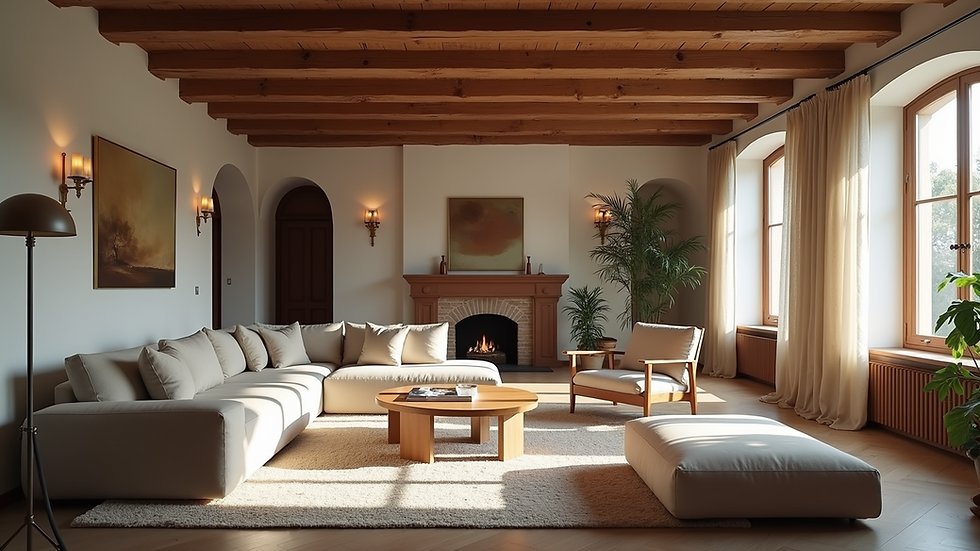Creating Functional Homes Blending Old and New Design
- Jen Greenberg
- 4 days ago
- 4 min read
Creating a home that feels both timeless and practical can be a challenge. Many homeowners want to preserve the charm of older architectural styles while enjoying the conveniences of modern living. The key lies in blending old and new design elements thoughtfully to create spaces that are not only beautiful but also functional. This post explores how to achieve that balance, offering practical tips and examples to inspire your next home project.

Understanding the Appeal of Mixing Old and New
Older homes often have unique architectural details like crown molding, hardwood floors, and built-in cabinetry. These features add character and warmth that many new builds lack. On the other hand, modern design focuses on clean lines, open spaces, and efficient use of technology.
When you combine these styles, you get the best of both worlds:
Character and warmth from historic elements
Comfort and convenience from modern updates
A personalized space that reflects your taste
This approach also supports sustainability by preserving existing structures and reducing waste.
Planning Your Blend of Styles
Start by assessing the existing features of your home. Identify what you want to keep and what needs updating. Here are some steps to guide your planning:
List architectural details worth preserving such as fireplaces, moldings, or original flooring.
Determine your lifestyle needs like more storage, better lighting, or open-plan living.
Set a budget that balances restoration costs with new installations.
Choose a design theme that can unify old and new elements, such as rustic modern or industrial chic.
Key Areas to Focus On
Kitchen
Kitchens are often the heart of the home and a great place to blend styles. For example:
Retain original cabinetry or exposed brick walls.
Add modern appliances with sleek finishes.
Use a farmhouse sink paired with quartz countertops.
Install open shelving to showcase vintage dishware alongside contemporary pieces.
Living Room
The living room offers many opportunities to mix design elements:
Keep original hardwood floors and add a modern area rug.
Combine an antique coffee table with minimalist sofas.
Use lighting fixtures that contrast old-world charm with modern simplicity.
Incorporate technology discreetly, such as hidden speakers or smart thermostats.
Bathrooms
Bathrooms can feel dated or cramped in older homes. To update them:
Preserve classic tile patterns but refresh with new grout and sealants.
Install modern fixtures like rain showers or floating vanities.
Use mirrors with vintage frames alongside contemporary lighting.
Improve ventilation and add energy-efficient water heaters.
Choosing Materials That Work Together
Materials play a big role in blending old and new design. Here are some combinations that work well:
Wood and metal: Pair reclaimed wood beams with black steel accents.
Stone and glass: Use natural stone walls with large glass windows or doors.
Brick and concrete: Expose brick walls and complement with polished concrete floors.
Textiles: Mix traditional fabrics like linen or wool with modern synthetic blends for durability.
Color Palettes That Bridge Eras
Color can unify contrasting styles. Consider these approaches:
Use neutral tones like whites, grays, and beiges as a base.
Add pops of color inspired by vintage palettes, such as muted blues or deep greens.
Incorporate metallic finishes like brass or copper for warmth.
Balance dark and light shades to create depth and interest.
Furniture and Decor Tips
Furniture choices can either clash or harmonize old and new design. To get it right:
Mix antique pieces with contemporary furniture to create focal points.
Choose simple, clean-lined furniture to offset ornate architectural details.
Use vintage rugs or artwork to add personality.
Avoid overcrowding; let each piece stand out.
Lighting That Enhances Both Styles
Lighting can highlight architectural features and improve functionality:
Use chandeliers or pendant lights with a vintage look in key areas.
Add recessed lighting or LED strips for modern convenience.
Place lamps with classic shapes but modern finishes.
Consider natural light by enlarging windows or adding skylights.
Technology Integration Without Sacrificing Style
Modern technology can improve comfort and efficiency without disrupting design:
Install smart thermostats and lighting controls hidden from view.
Use wireless speakers and charging stations integrated into furniture.
Choose appliances with retro designs but modern features.
Conceal wiring and devices to maintain clean aesthetics.
Case Study: A Successful Blend in a Historic Home
A family in Boston renovated their 1920s colonial home by preserving original hardwood floors and crown molding. They opened the kitchen to the dining room, adding quartz countertops and stainless steel appliances. The living room features a restored fireplace alongside a minimalist sofa and modern lighting. The bathroom keeps classic subway tiles but includes a frameless glass shower and floating vanity. This blend created a warm, functional space that respects the home’s history while meeting contemporary needs.
Common Challenges and How to Overcome Them
Mismatch of styles: Create a mood board to visualize how elements work together before committing.
Budget overruns: Prioritize key features to restore and choose cost-effective modern updates.
Structural issues: Consult professionals to ensure safety when altering old buildings.
Finding the right furniture: Explore vintage shops and custom makers for unique pieces.
Final Thoughts on Creating Functional Homes
Blending old and new design requires thoughtful planning and a clear vision. By preserving character while adding modern comforts, you create a home that feels authentic and livable. Start small, focus on key areas, and let your personality guide the choices. The result will be a space that honors the past and embraces the future.
Take the first step by identifying one area in your home where you can combine classic charm with modern function. Whether it’s updating a kitchen or refreshing a living room, blending styles can transform your house into a truly functional home.


Comments